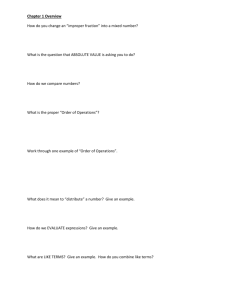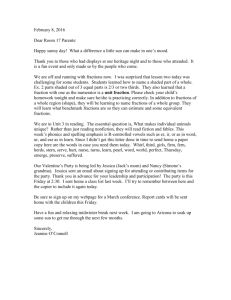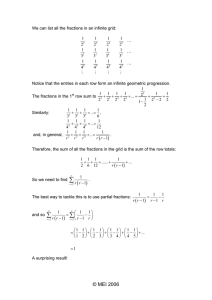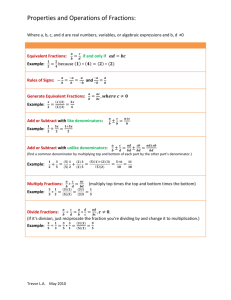Current Research Journal of Biological Sciences 5(2): 75-80, 2013
advertisement
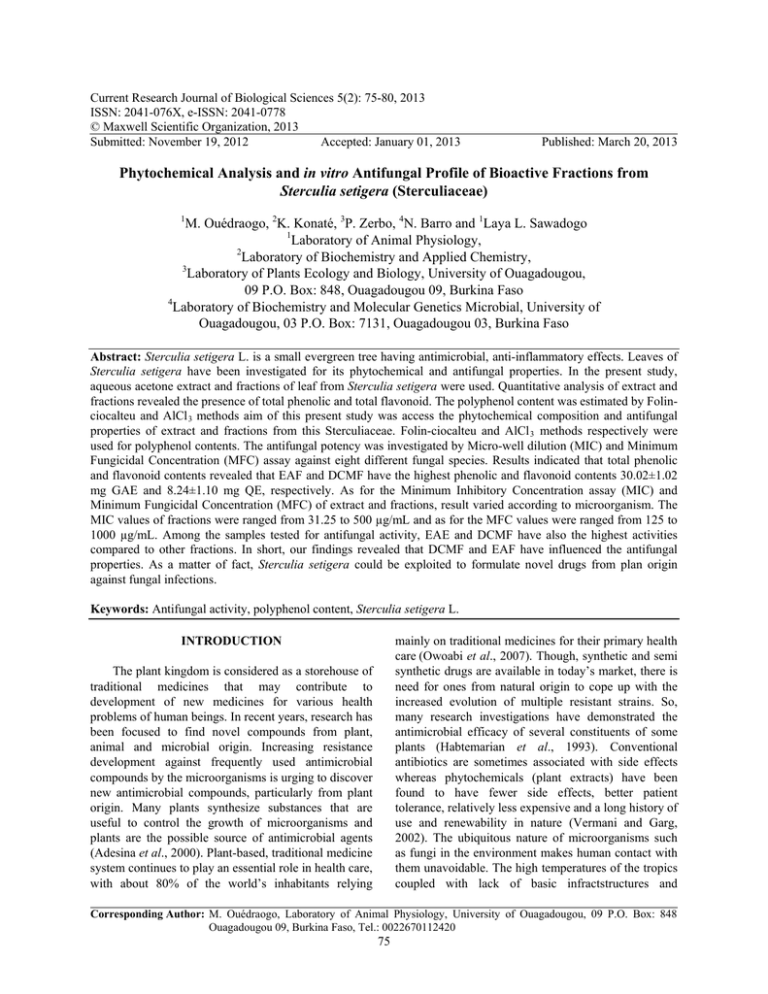
Current Research Journal of Biological Sciences 5(2): 75-80, 2013 ISSN: 2041-076X, e-ISSN: 2041-0778 © Maxwell Scientific Organization, 2013 Submitted: November 19, 2012 Accepted: January 01, 2013 Published: March 20, 2013 Phytochemical Analysis and in vitro Antifungal Profile of Bioactive Fractions from Sterculia setigera (Sterculiaceae) 1 M. Ouédraogo, 2K. Konaté, 3P. Zerbo, 4N. Barro and 1Laya L. Sawadogo 1 Laboratory of Animal Physiology, 2 Laboratory of Biochemistry and Applied Chemistry, 3 Laboratory of Plants Ecology and Biology, University of Ouagadougou, 09 P.O. Box: 848, Ouagadougou 09, Burkina Faso 4 Laboratory of Biochemistry and Molecular Genetics Microbial, University of Ouagadougou, 03 P.O. Box: 7131, Ouagadougou 03, Burkina Faso Abstract: Sterculia setigera L. is a small evergreen tree having antimicrobial, anti-inflammatory effects. Leaves of Sterculia setigera have been investigated for its phytochemical and antifungal properties. In the present study, aqueous acetone extract and fractions of leaf from Sterculia setigera were used. Quantitative analysis of extract and fractions revealed the presence of total phenolic and total flavonoid. The polyphenol content was estimated by Folinciocalteu and AlCl 3 methods aim of this present study was access the phytochemical composition and antifungal properties of extract and fractions from this Sterculiaceae. Folin-ciocalteu and AlCl 3 methods respectively were used for polyphenol contents. The antifungal potency was investigated by Micro-well dilution (MIC) and Minimum Fungicidal Concentration (MFC) assay against eight different fungal species. Results indicated that total phenolic and flavonoid contents revealed that EAF and DCMF have the highest phenolic and flavonoid contents 30.02±1.02 mg GAE and 8.24±1.10 mg QE, respectively. As for the Minimum Inhibitory Concentration assay (MIC) and Minimum Fungicidal Concentration (MFC) of extract and fractions, result varied according to microorganism. The MIC values of fractions were ranged from 31.25 to 500 µg/mL and as for the MFC values were ranged from 125 to 1000 µg/mL. Among the samples tested for antifungal activity, EAE and DCMF have also the highest activities compared to other fractions. In short, our findings revealed that DCMF and EAF have influenced the antifungal properties. As a matter of fact, Sterculia setigera could be exploited to formulate novel drugs from plan origin against fungal infections. Keywords: Antifungal activity, polyphenol content, Sterculia setigera L. mainly on traditional medicines for their primary health care (Owoabi et al., 2007). Though, synthetic and semi synthetic drugs are available in today’s market, there is need for ones from natural origin to cope up with the increased evolution of multiple resistant strains. So, many research investigations have demonstrated the antimicrobial efficacy of several constituents of some plants (Habtemarian et al., 1993). Conventional antibiotics are sometimes associated with side effects whereas phytochemicals (plant extracts) have been found to have fewer side effects, better patient tolerance, relatively less expensive and a long history of use and renewability in nature (Vermani and Garg, 2002). The ubiquitous nature of microorganisms such as fungi in the environment makes human contact with them unavoidable. The high temperatures of the tropics coupled with lack of basic infractstructures and INTRODUCTION The plant kingdom is considered as a storehouse of traditional medicines that may contribute to development of new medicines for various health problems of human beings. In recent years, research has been focused to find novel compounds from plant, animal and microbial origin. Increasing resistance development against frequently used antimicrobial compounds by the microorganisms is urging to discover new antimicrobial compounds, particularly from plant origin. Many plants synthesize substances that are useful to control the growth of microorganisms and plants are the possible source of antimicrobial agents (Adesina et al., 2000). Plant-based, traditional medicine system continues to play an essential role in health care, with about 80% of the world’s inhabitants relying Corresponding Author: M. Ouédraogo, Laboratory of Animal Physiology, University of Ouagadougou, 09 P.O. Box: 848 Ouagadougou 09, Burkina Faso, Tel.: 0022670112420 75 Curr. Res. J. Biol. Sci., 5(2): 75-80, 2013 Chemicals: For evaluate phytochemical composition and antifungal profile solvents and various classic reagents were used. All reagents and all other chemicals were of analytical grade. Folin-Ciocalteu reagent, carbonate de sodium (Na 2 CO 3 ), gallic acid, quercetin, trichlorure d’ammonium (AlCl 3 ) were purchased from Sigma-Aldrich chemie (Steinheim, Germany); acetone, methanol, ethanol hexane, Dichloromethane (DCM), acetate of ethyl, n-butanol were supplied by Fluka chemie (Buchs, Switzerland). INT (piodonitrotetrazolium chloride) was purchased from sigma-Aldrich chemie (Steinheim, Germany). unsanitary production conditions prevailing in most developing countries predispose many food products, fruits and vegetables to spoilage. Several outbreaks of aflatoxicosis attributed to Aspergillus flavus have been documented in rural human populations in tropical countries (Peraica et al., 1999). Some strains of A. niger produces a potent mycotoxin called ochratoxins A; a human carcinogen found in grains and wine products (Samson et al., 2004; Schuster et al., 2002). Additionally, many fungi are parasites on plants and animals (including humans) causing serious diseases in humans such as aspergilloses, candidoses, coccidioidomycosis, mycetomas, among others. Furthermore, persons with immune-deficiencies are particularly susceptible to diseases by Aspergillus, candida and Cryptoccocus (Nielsen and Heitman, 2007). Candida herbarum is the most important allergenic species and has been shown to have the ability of triggering allergic reactions in sensitive individuals. Prolonged exposure to elevated spore concentrations can elicit chronic allergy and asthma (Samson et al., 2001). Numerous naturally occurring phytochemicals are present in plant tissues and many studies have evaluated their antimicrobial activities in several plant extracts as Garlic (Allium sativum) against bacteria (Cavallito and Bailey, 1944), fungi (Adetumbi et al., 1986) and viruses (Weber et al., 1992). Sterculia setigera however, belonging to the family of Sterculiaceae is commonly known and ethnobotanical investigations in the central region of Burkina Faso have shown that Sterculia setigera is used frequently and widely in traditional medicine to treat various kinds of diseases such as fever, pain, variola, antibacterial, anti-viral activities and hepatoprotective (Nacoulma, 1996). Phytochemical analysis of the leafy stick of this sterculiaceae has mainly demonstrated the presence of saponosides, coumarins, steroids, polyphenol compounds and alkaloids (Nacoulma, 1996). The objectives of the present study were to investigate on the one hand the polyphenol content and on the other, to evaluate the antifungal profile of bioactive fractions from Sterculia setigera in order to provide a scientific basis for the traditional use of this sterculiaceae. Test microorganisms: The microorganisms used in this study consisted of eight different fungal species: Candida albicans ATCC 90028, C. tropicalis ATCC 750, Cryptococcus neoformans ATCC 66031, Aspergillus niger ATCC 322, Penicillium chrysogenum ATCC 5476, Aspergillus flavus ATCC 227, Tricophyton rubrum ATCC 2327 and Candida krusei ATCC 6258. Fungal strains were maintained on agar slant at 4°C and sub-cultured on a fresh appropriate agar plates 24 h prior to any antifungal activity. Sabouraud Glucose Agar was used for the activation of fungi. The Mueller Hinton Broth (MHB) was used for the MIC and MFC determinations. METHODOLOGY Extraction and fractionation: Fifty grams (50 g) of powdered plant material were extracted with 80% aqueous acetone (500 mL) in 1/10 ratio (w/v) for 24 h under mechanic agitation (SM 25 shaker, Edmund BÜHLER, Germany) at room temperature. After filtration, acetone was removed under reduced pressure in a rotary evaporator (BÜCHI, Rotavopor R-200, Switzeland) at approximately 40°C. The aqueous extracts were subjected to sequential liquid-liquid extraction with n-hexane, dichloromethane, ethyl acetate and n-butanol. Each fraction was then collected and concentrated to dryness under reduced pressure to obtain n-Hexane Fraction (n-HF), Dichloromethane Fraction (DCMF), Ethyl Acetate Fraction (EAF) and nButanol Fraction (n-BF). The different fractions were freeze-dried by Telstar Cryodos 50 freeze-dryer. The fraction residues were packed in waterproof plastic flasks and stored at 4°C until use. MATERIALS Polyphenols determination: Total phenolic content: Total polyphenols were determined by Folin-Ciocalteu method as described by (Lamien-Meda et al., 2008). Aliquots (125 µL) of solution from each fraction in methanol (10 mg/mL) were mixed with 625 µL Folin-Ciocalteu reagent (0.2 N). After 5 min, 500 µL of aqueous Na 2 CO 3 (75 g/L) were added and the mixture was vortexed. After 2 h of incubation in the dark at room temperature, the absorbencies were measured at 760 nm against a blank Plants material: Sterculia setigera (sterculiacea) was freshly collected in August 2006 in Saaba, 4 Km east of Ouagadougou, capital of Burkina Faso. The plant was botanically identified by Prof. Millogo-Rasolodimby from the plant Biology Department of the University of Ouagadougou. Voucher specimen (ID-10476) was deposited at the Herbarium of the “Laboratoire de Biologie et d’ Ecologie Végétale, UFR/SVT of University of Ouagadougou”. 76 Curr. Res. J. Biol. Sci., 5(2): 75-80, 2013 (0.5 mL Folin-Ciocalteu reagent +1 mL Na 2 CO 3 ) on a UV/visible light spectrophotometer (CECIL CE 2041, CECIL Instruments, England). The experiments were carried out in triplicate. A standard calibration curve was plotted using gallic acid (Y = 0.0289x - 0.0036; R2 = 0.9998). The results were expressed as mg of Gallic Acid Equivalents (GAE)/100 mg of fractions. for 48 h. All tests were performed in triplicate and the fungi activity was expressed as the mean of inhibitions produced. Viable microorganisms reduced the yellow dye to a pink color. The MIC was defined as the lowest concentration of the total alkaloid fractions substance at which no colony was observed after incubation. So, the MIC was defined as the lowest concentration where no change was observed, indicating no growth of microorganism. Total flavonoid content: The total flavonoids were estimated according to the Dowd method as adapted by Lamien-Meda et al. (2008). (0.5 mL) of methanolic AlCl 3 (2%, w/v) were mixed with 0.5 mL of each fraction solution (0.1 mg/mL). After 10 min, the absorbencies were measured at 415 nm against a blank (mixture of 0.5 mL fraction solutions and 0.5 mL methanol) on a UV/visible light spectrophotometer (CECIL CE 2041, CECIL Instruments, England) and compared to a quercetin calibration curve (Y = 0.0289x - 0.0036; R2 = 0.9998). The data obtained were the means of three determinations. The amounts of flavonoids in plant fractions were expressed as mg of Quercetin Equivalents (QE) /100 mg of fractions. Minimum Fungicidal Concentration (MFC): Minimum Fungicidal Concentration (MFC) was determined by the micro dilution method in culture broth as recommended by Konaté et al. (2012) with low modifications. Minimum Fungicidal Concentration (MFC) was determined by adding 50 µL aliquots of the clear wells to 150 µL of freshly prepared broth medium and incubating at 35°C for 48 h. The MFC was regarded as the lowest concentration of test sample which did not produced a color. All tests were performed in triplicates. RESULTS In vitro antifungal activity: Preparation of inocula: The fungal strains grown on nutrient agar (Muller Hinton broth) at 35°C for 72 h were suspended in a saline solution (0.9%, w/v) NaCl and adjusted to a turbidity of 0.5 Mac Farland standard (5×105 CFU/mL) (Konaté et al., 2012) with low modifications. Polyphenol content: The total phenolics content per 100 mg of Sterculia setigera extract and fractions ranged from 30.02±1.02 to 13.17±1.02 mg GAE. The highest content of total phenolics was detected in EAF with 30.02±1.02 mg GAE following by DCMF with 28.13±0.15 mg GAE. The lowest total phenolics were obtained in HF with, respectively 13.17±1.02 mg GAE. The total flavonoids content per 100 mg of Sterculia setigera extract and fractions ranged from 8.24±1.10 to 3.60±0.22 mg QE. The highest content of total flavonoids in Sterculia setigera was detected in DCMF with 8.24±1.10 mg QE following by EAF with 7.36±0.63 mg QE. The lowest total flavonoids were obtained in HF with, respectively 3.60±0.22 mg QE. The results are recorded in the (Fig. 1). Preparation of fraction substances: The stock solutions of fractions were dissolved in 10% Dimethylsulfoxide (DMSO) in water at a final concentration of 1000 μg/mL. The stock solutions were sterilized by filtration through 0.22 μm sterilizing Millipore express filter. Minimum Inhibitory Concentration (MIC) assay: Minimum Inhibitory Concentration (MIC) was determined by the micro dilution method in culture broth as recommended by Konaté et al. (2012) with low modifications. Twelve serial two-fold dilutions of fraction solutions or conventional antibiotic were prepared as described before, to obtain final concentration ranges of 1000-1.953 and 50-0.0488 µg/mL for fractions and reference substances, respectively. The last wells (n°12) served as sterility controls (contained broth only) or negative control (broth + inoculums). The 96-well micro-plates (NUNC, Danemark) containing 100 μL of Mueller Hinton (MH) broth were used. For each fungi strain, three columns of eight wells to the micro-plate were used. Each well has getting: the culture medium + fraction solution + inoculum standardized at 5×105 CFU/mL (10 μL of inocula) and INT (50 μL; 0.2 mg/mL for 30 min). The plates were sealed with parafilm, then agitated with a plate shaker to mix their contents and incubated at 35°C Antifungal activity: As for the Minimum Inhibitory Concentration assay (MIC) and Minimum Fungicidal Concentration (MFC) of extract and fractions, result varied according to microorganism (Table 1). The MIC values of fractions were ranged from 31.25 to 500 µg/mL and as for the MFC values were ranged from 125 to 1000 µg/mL (Table 2). The results obtained in this study indicate a considerable difference in antifungal activity of extract and fractions. DISCUSSION Medicinal plants remedies used in folk medicine provide an interesting and still largely unexplored source for the creation and development of potentially new drugs for chemotherapy which might help overcome the growing problem of resistance and also the toxicity of the currently available commercial antibiotics (Alam et al., 2009). There are a lot of 77 Curr. Res. J. Biol. Sci., 5(2): 75-80, 2013 35 Extract and fractions from Sterculia setigera Total Pheno 30 30.02 Total Flavo 28.13 23.6 25 20 15.12 13.17 15 8.24 10 5 8.02 6.52 4.02 2.6 0 EHA HF DCMF EAF BF Total phenolic and total flavonoid contents Fig. 1: Polyphenol content of extract and fractions from Sterculia setigera L. Table 1: Minimum Inhibitory Concentration (MIC) of extract and fractions from Sterculia setigera C. al. C. tro. C. neo. A. n. A. f. P. ch. T. r. C. kr. EHA 125 250 250 125 125 250 250 125 HF 250 250 500 125 125 250 500 250 DCMF 62.50 125 125 62.5 31.25 125 250 125 EAF 31.25 125 250 62.5 62.50 125 125 62.5 BF 62.50 125 125 62.5 62.50 125 125 125 C. al: Candida albicans; C. tro: C. tropicalis; C. neo: Cryptococcus neoformans; A. n: Aspergillus niger; P. c: Penicillium chrysogenum; A. f: Aspergillus flavus; T. r: Tricophyton rubrum; C. kr: Candida krusei; The results are the means of number of the colonies±standard deviations Table 2: Minimum Fungicidal Concentration (MFC) of extract and fractions from Sterculia setigera C. al. C. tro. C. neo. A. n. A. f. EHA 500 1000 500 250 250 FH 500 ˃1000 1000 500 500 DCMF 250 500 500 125 125 EAF 250 500 500 125 125 BF 250 1000 500 250 125 The results are the means of number of the colonies±standard deviations antimicrobial drugs of which some are discovered or established and over 250,000 undiscovered flowering plants with medicinal properties exist worldwide (Madureira, 2008). Hence, the last decade witnessed an increase in the investigations on plants as a source of human disease management (Woldemichael et al., 2003; Aiyelaagbe, 2001) and more natural antimicrobials have driven scientists to investigate the effectiveness of inhibitory compounds such as extracts from plants (Nasar-Abbas and Halkman, 2004). The World Health Organization (WHO, 2000) has estimated that between the years 2000 and 2020 nearly one billion people will be infected and more than 200 million will develop the disease. Therefore, it is of great interest to carry out a screening of these plants in order to validate their use in folk medicine and to reveal the active principle by isolation and characterization of their constituents. The phytochemical screening revealed the presence of polyphenol compounds, saponosides, coumarins, P. ch. 1000 ˃1000 500 500 500 T. r. 1000 ˃1000 1000 500 500 C. kr. 500 1000 250 250 250 steroids and triterpenies (Nacoulma, 1996). These bioactive compounds are naturally occurring in most plant materials, known to be antimicrobial, thus conferring the antimicrobial property to plants (El-Astal et al., 2005). In this present study, acetone 80% was used as solvent. In effect, according certain studies, acetone 80% is the best extraction solvent to extract the different secondary metabolites. Moreover, acetone extracts content more phenolic compounds than the other solvents (Sun and Ho, 2005). The results obtained in this study confirmed this statement. Our results showed that Sterculia setigera presented the highest amount of polyphenol content. The abundance of our extracts in polyphenols may explain the utility of Sterculia setigera in the treatment of infectious diseases (Nacoulma, 1996). As a matter of fact, secondary metabolites, such as flavonoids, are important antimicrobial activity (Scalbert, 1991). Therefore, the presence of flavonoids, phenolic or terpenoids in this plant has been shown to be responsible for 78 Curr. Res. J. Biol. Sci., 5(2): 75-80, 2013 antimicrobial activity in plants (Nostro et al., 2000). Their role is to protect plants against microbial or insect damage (Cowan, 1999). Since medicinal plants contain pharmacologically active substances with antimycobacterial, antibacterial and antifungal properties (Mariita et al., 2011), the antifungal activity of the plant tested could therefore be attributed to the presence of these compounds. Konaté, K., A. Hilou, J.F. Mavoungou, A.L. Lepengué, A. Souza, N. Barro, J.Y. Datté, B. M’Batchi and O.G. Nacoulma, 2012. Antimicrobial activity of polyphenol-rich fractions from Sida alba L. (Malvaceae) against cotrimoxazol-resistant bacteria strains. Ann. Clin. Microbiol. Antimicrobials, 11: 5, Doi: 10.1186/1476-0711-11-5. Lamien-Meda, A., C.E. Lamien, M.M.Y. Compaoré, R.T.N. Meda, M. Kiendrebeogo, B. Zeba, J.F. Millogo and O.G. Nacoulma, 2008. Polyphenol content and antioxidant activity of fourteen wild elible fruits from Burkina Faso. Molecules, 13: 581-594. Madureira, M.D.C., 2008. Rediscovering traditional medicine. Spore, 136: 16-17. Mariita, R.M., C.K.P.O. Ogol, N.O. Oguge and P.O. Okemo, 2011. Methanol extract of three medicinal plants from samburu in northern Keneya show significant antimycobacterial, antibacterial and antifungal properties. Res. J. Med. Plant, 5: 54-64. Nacoulma, O.G., 1996. Medicinal plants and their traditional uses in Burkina Faso. Ph.D. Thesis, University of Ouagadougou, pp: 328. Nasar-Abbas, S.M. and A.K. Halkman, 2004. Antimicrobial effect of water extract of sumac (Rhus coriaria L.) on the growth of some food borne bacteria including pathogens. Int. J. Food Microbiol., 97: 63-69. Nielsen, K. and J. Heitman, 2007. Sex and virulence of human pathogenic fungi. Adv. Genet., 57: 143-173. Nostro, A., M.P. Germano, V. D’Angelo, A. Marino and M.A. Cannatelli, 2000. Extraction methods and bioautography for evaluation of medicinal plant antimicrobial activity. Lett. Appl. Microbial., 30: 379-384. Owoabi, O.J., E.K.I. Omogbai and O. Obasuyi, 2007. Antifungal and antibacterial activities of the ethanolic and aqueous extract of Kigella Africana (Bignoniaceae) stem bark. Afr. J. Biotechnol., 6: 1677-1680. Peraica, M., B. Radic, A. Lucic and M. Pavlovic, 1999. Toxic effects of mycotoxins in humans. Bull. World Health Org., 77: 754-766. Samson, R.A., J. Houbraken, R.C. Summerbell, B. Flanningan and J.D. Miller, 2001. Common and Important Species of Fungi and Actinomycetes in Indoor Environments. In: Flanningan, B., R.A. Samson and J.D. Miller (Eds.), Microorganisms in Home and Indoor Work Environments. Taylor and Francis, New York, pp: 287-292. Samson, R.A., J.A.M.P. Houbraken, A.F.A. Kuijpers, J.M. Frank and J.C. Frisvad, 2004. New ochratoxin A or sclerotium producing species in Aspergillus section Nigri. Stud. Mycol., 50: 45-46. CONCLUSION In short, this present study showed that the extract and fractions from Sterculia setigera demonstrated moderate antimicrobial activity. Therefore, Sterculia setigera which was traditionally used as plant may be an interesting and largely unexplored source for the development of potential new compounds. But it would be necessary to isolate the active principles and characterize their constituents for the benefit of human being for further studies. ACKNOWLEDGMENT The authors think Prof. Millogo Rasolodimby from the plants Biology Department of the University of Ouagadougou for the botanically identified of plants. REFERENCES Adesina, S.K., O. Idowu, A.O. Ogundaini, H. Oladimeji, T.A. Olugbade, G.O. Onawunmi and M. Pais, 2000. Antimicrobial constituents of the leaves of Acalypha wilkesiana and Acalypha hispida. Phytother. Res., 14: 371-374. Adetumbi, M.A., G.T. Javor and B.H. Lau, 1986. Allium sativum (garlic) inhibits lipid synthesis by Candida albicans. Antimicrob. Agents Chemother, 30: 499-501. Aiyelaagbe, O.O., 2001. Antibacterial activity of Jatropa multifida roots. Fitoterapia, 72: 544-546. Alam, M.T., M.M. Karim and S.N. Khan, 2009. Antibacterial activity of different organic extracts of Achyranthes aspera and Cassia alata. J. Sci. Res., 1: 393-398. Cavallito, C.J. and J.H. Bailey, 1944. Allicin, the antibacterial principle of Allium sativum. I. isolation, physical properties and antibacterial action. J. Am. Chem. Soc., 66: 1950-1951. Cowan, M., 1999. Plants products as antimicrobial agents. Clin. Microbiol. Rev., 12: 564-582. El-Astal, Z.Y., A.E.A. Ashour and A.A.M. Kerrit, 2005. Antimicrobial activity of some medicinal palnt extracts in Palestine. Pak. J. Med. Sci., 21: 187-193. Habtemarian, S., A.I. Gray and P.G. Waterman, 1993. A new antibacterial sesquiterpene from Premma oligotrichia. J. Nat. Prod., 56: 140-143. 79 Curr. Res. J. Biol. Sci., 5(2): 75-80, 2013 Scalbert, A., 1991. Antimicrobial properties of tannins. Phytochemistry, 30: 3875-3883. Schuster, E., N. Dunn-Coleman, J.C. Frisvad and P.W. Van Dijick, 2002. One the safety of Aspergillus Niger: A review. Appl. Microbiol. Biotechnol., 59: 426-435. Sun, T. and C.T. Ho, 2005. Antioxidant activities of buck wheat extracts. Food Chem., 90: 743-749. Vermani, K. and S. Garg, 2002. Herbal medicine for sexually transmitted disease and AIDS. J. Ethnopharmacol., 80: 49-66. Weber, N.D., D.O. Anderson, J.A. North, B.K. Murray, L.D. Lawson and B.G. Huger, 1992. In vitro vinicidal activity of Alium stivum (Garlic) extracts and compounds. Plant. Med., 58: 417-423. WHO, 2000. Anti-tuberculosis drug resistance in the world: Report No. 2: Prevalence and trends; the WHO/IUATLD global project on anti-tuberculosis drug resistance surveillance. Communicable Diseases, World Health Organization, Geneva, Switzerland 2000. Retrieved from: http:// www. emro. Who. Int/stb/media/pdf/withoutannexes.pdf. Woldemichael, G.M., G. Wachter, M.P. Singh, W.M. Maiese and B.N. Timmermann, 2003. Antibacterial diterpenes from Calceolaria pinifolia. J. Nat. Prod., 66: 242-246. 80
